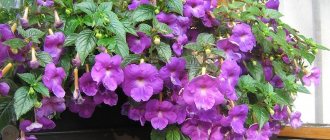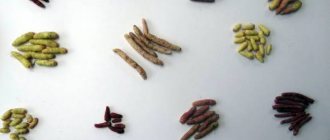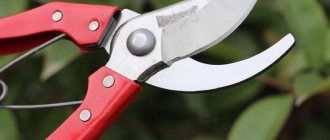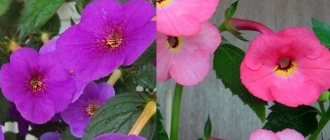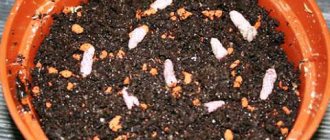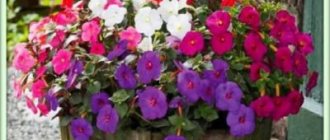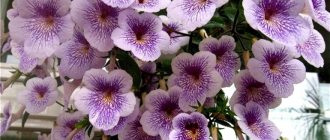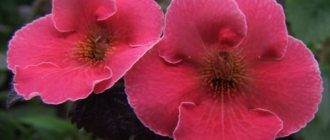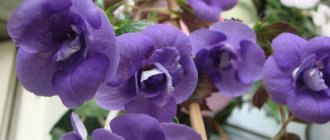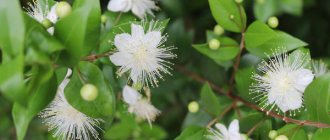Achimenes is a 40-species genus of perennial flowering plants belonging to the Gesneriaceae family. It is the closest relative of violet, streptocarpus and gloxinia. In Russia, the genus is much less known than in Western Europe and America. Varieties of Achimenos with names and photos will allow you to get to know the culture better; it deserves greater popularity, and can take its rightful place on the windowsills of domestic flower lovers.
Achimenes varieties and hybrids deserve more attention
Achimenes in nature and culture
In nature, exotics grow in the tropical forests of South and Central America. It belongs to the Gesneriaceae family and is a close relative of Saintpaulias, Streptocarpus and violets, popular among gardeners. Achimenes began to be grown as a cultivated plant in the 18th century. Today they decorate many gardens, greenhouses and home flower beds.
The beauty of the flowering of wild “brothers” of Achimenes can be observed all year round. At home, with proper care, the period of riot of colors lasts only up to six months, giving way to a state of rest.
These beautifully flowering perennials come in many varieties, differing in foliage shape, flower size and color. But they all have one thing in common - long creeping stems that effectively hang from the walls of the container, forming an openwork vertical carpet. Achimenes are famous for their abundant and lush flowering, which is replete with a wide palette of color shades.
Achimenes are among the heat-loving plants. This is indicated by the name of the culture, which when literally translated means “Achimenes” = “a” (no) + “chimenes” (cold).
Diseases and pests
Among the pests, Achimenes is susceptible to infection by aphids, thrips and spider mites. At the first signs of their appearance, it is necessary to treat the plant with an insecticide solution.
Among the diseases the flower is affected by:
- Chlorosis, which occurs when the temperature is not maintained, improper lighting and lack of nutrients. In this case, it is necessary to optimize the conditions for keeping the plant;
- Fungal diseases, such as spotting and various rots, which can affect all parts of the plant. It is necessary to remove the affected areas and treat with a fungicide;
- Bacteriosis, for the treatment of which antibacterial drugs are used.
These diseases are quite difficult to treat, and if they are severely neglected, the plant may die completely. Therefore, it is necessary to regularly carry out preventive examinations of Achimenes and provide proper care for it. Then it will delight you with its bright, charming blooms for a long time.
This video will also help you in caring for Achimenes:
Popular varieties
Today, several varieties of Achimenes are distinguished in cultivation, on the basis of which dozens of varieties have been bred. The most popular among them are described below:
- Long-flowered - plants up to 30 cm high. The ampelous stems are decorated with slightly elongated pubescent leaves of light green color. Large flowers are located singly in the axils of the leaves.
- Large-flowered - bushes up to 60 cm high. Erect stems are decorated with large elongated leaves. Purple-red flowers are arranged in pairs in the axils of the leaves.
- Hybrid - forms created by crossing several species. The ampelous or erect stems are decorated with pointed, pubescent leaves with jagged edges. They are famous for the original colors of their flowers, which delight with their abundant blooms.
Plants can have both regular and double flower shapes. The color palette of shades is wide. It covers all shades, starting with light shades such as white, yellow, pink, coral, lilac, blue and ending with dark ones - violet and sea green.
A brief description of the most popular varieties of Achimenes:
- Blue Star - bushes with erect stems, decorated with large flowers with corollas of a violet-blue hue. The petals have interesting colors in the form of applied strokes.
- Peach Cascade - bushes with erect, slightly drooping shoots are decorated with spectacular peach-orange flowers with a yellow spot at the central point.
- Serge Saliba - bushes with erect stems, decorated with two-tone “stars” with a yellow core and pinkish edges.
- Glory are compact ampelous plants that delight with abundant blooming of spectacular flowers with a yellow core and scarlet petals.
- Double Pink Rose - lush flowering bushes with semi-double flowers of a pale pink hue, vaguely reminiscent of half-opened rose buds in shape.
- Purple King - bushes with erect stems, decorated with large lilac flowers with yellow speckled throats. The long-flowering variety pleases the eye from early spring to late autumn.
- Sauline - plants with erect stems, crowned with small flowers with jagged edges of an original lemon-purple color. Depending on the growing conditions, the color tone can change from yellow to pink.
- Lavender Fancy - ampelous plants with burgundy stems and light green foliage, decorated with simple flowers of striped creamy-brown color.
- Peach Blossom - ampel-shaped bushes. They are distinguished by spectacular foliage, the upper part of which has a dark green tint, and the lower part is burgundy. The flowers of the plant also include two shades: the center is decorated with a purple “eye”, the edges are pale pink.
What does the plant look like?
The flower of the india variety is a large inflorescence of five petals of a bright blue hue, covered, as it were, with rays of the darkest blue hue emanating from the center of the flower. The center, in turn, has a rich burgundy hue, which smoothly turns into bright blue. There are a lot of these buds on the stem, and the formation of a cascade makes a carpet of burgundy-blue from these flowers.
This flower will decorate any room, be it a residential apartment or house, or an office space. If the flower has enough moisture, warmth and light, then it will bloom almost all year round, except for the winter period.
How to grow at home
A guarantee of the beauty and duration of flowering of Achimenes is good care of the plant. If you follow simple maintenance rules, the flowering of the bush can be extended up to 6 months.
Soil composition
Achimenes is not particularly demanding in care. Light, well-drained, slightly acidic soil is best suited for its cultivation. To obtain the desired composition, two parts of leaf soil are mixed with one part of peat and sand.
Selecting a location
Achimenes are heat-loving plants. They feel most comfortable on windows facing south. During flowering, exotics are vulnerable to direct sunlight. With abundant light, their buds acquire a brown tint, and the colors become less bright and saturated. During this period, it is better to move them to a place with diffused light.
At the same time, you should avoid shaded areas. The fact that the exotic plant does not have enough sunlight will be indicated by stretching bare stems and crushed foliage.
Important point! You can determine how sun-loving a plant is visually: bushes with dark foliage need more light than those with delicate greenery.
Temperature
One of the key conditions for successfully growing achimenes at home is maintaining the temperature regime. During the period of active growth and flowering, the optimal temperature for exotics is varying between 22-24°C. In hot months, when the ambient temperature at night drops to +20°C, the bush can be safely left on an open balcony or veranda.
During the rest period, the temperature threshold can be lowered to +18°C. When preparing a plant for wintering, the temperature should be lowered gradually. This will allow the plant roots to gain the necessary substances before hibernation, thereby minimizing stress.
Humidity and watering
Heat-loving exotic requires regular watering. For this purpose, use water at room temperature, pre-settled for 24 hours. The delicate plant instantly reacts to cold water by developing brown spots on the leaves.
Watering is carried out only during the “awake” period of the bush, accompanied by active growth and flowering. The plant is watered as the earthen clod dries. During the dormant period, the flower is not watered at all.
Important point! It is necessary to water strictly at the root of the bush, minimizing the risk of moisture getting on the leaves and flowers.
Achimenes is a tropical plant by nature. It feels most comfortable when the air humidity is within 60%. For moistening, it is convenient to use trays with wet pebbles placed in close proximity.
Fertilizer application
During the period of growing green mass and abundant flowering, Achimenes needs regular feeding. For this purpose, complex fertilizers intended for beautifully flowering plants are used. Fertilizers are applied once every two weeks. The first time is fed a month after awakening and transplanting the bush.
The main thing is not to overdo it. The bush may react to excess fertilizer by dropping leaves.
Caring for Achimenes after planting
Planting a young Achimenes can be done either in a hanging pot or in a regular one. The main thing is not to choose very deep containers; forms with a larger diameter are better suited, as this will saturate the rhizome with oxygen much better. It is worth starting the procedure at the end of February or beginning of March, when the air temperature gradually increases - the cultivation will be successful.
When strong shoots are already sprouting on the rhizome, you should start preparing for planting. To do this, select the healthiest and most overgrown specimens and insert them vertically into the ground. Place the shoots evenly around the entire perimeter of the pot. For a container with a diameter of 10-11 cm - approximately 3-4 rhizomes. Fill in a layer of soil and substrate up to 3-3.5 cm thick.
After planting Achimenes, proper care is required. The most favorable temperature is +22…+24 degrees. And in terms of watering, it is necessary to carefully monitor the soil moisture, preventing it from drying out. Pour warm water over the edge of the pot at least once a week. With proper care, sprouts will appear in about 7-10 days.
If Achimenes flowers are not properly cared for, problems with their health may arise. The plant may be affected by pests and diseases:
- Leaf spotting.
- Aphid.
- Soft-bodied mites.
- Viruses.
The causes of such problems can be watering with cold water, drafts, too much soil moisture, contaminated soil, low temperature, scorching sun rays, and soil lying due to insufficient drainage. To avoid such problems, monitor the growing conditions of your pet, and then it will delight you with its colorful, stunning flowering for many years.
How to transplant and prune a bush
Achimenes is replanted after each wintering at the end of the dormant period. Some gardeners successfully replant at the beginning of summer. Bushes are grown in containers with wide, low sides.
The procedure is performed in the following sequence:
- 30-60 minutes before replanting the achimenes, the container with the plant is watered abundantly.
- The rhizomes are removed from the pot and carefully cleaned of soil.
- The tubers are carefully inspected for damaged and rotten areas. If any are found, the sections are removed and treated with wood ash.
- The container is filled 1/3 with drainage, the role of which is played by sand mixed with vermiculite. The drainage is sprinkled with a layer of new soil mixture, on top of which a thin layer of sand is formed, and then the soil is again lined.
- Viable rhizomes of Achimenes - dark brown roots - are planted in a container with a new soil mixture, laying the roots at the level of the sand layer.
Important point! Treating and soaking the material in fungicidal compounds will help get rid of mold on the roots.
Some novice gardeners, in order to obtain a more variegated composition, plant several varieties in one container. It is not advisable to do this. Different varieties may differ in the speed of development. As a result: more powerful bushes will “oppress” the weaker ones.
Achimenes does not need pruning. The only exceptions are moments when young shoots build up green mass. In this case, to stimulate branching, they are pinched at the stage of the second and third leaves. The only “minus” of this pinching is the postponement of flowering by 2-3 weeks later.
Rhizomes are different!
Rhizomes of Achimenes
This is what Achimenes planting material looks like. These are rhizomes. Different varieties have different shapes of “earrings”. When is the best time to plant them? If you do not have the opportunity to provide additional lighting to the plants, it is better to postpone planting until March. If rhizomes begin to sprout during storage, you need to lower the temperature to +5...+8oC - the sprouts will freeze and will not stretch. To do this, we place the rhizoms in the refrigerator in the fruit drawer and check them regularly. Temperature - not lower than +5°C. It is better to plant sprouted rhizomes, since dormant rhizomes have a risk of rotting when watered. The best time for planting is February-March.
If you have the conditions for early planting, remove the planting material from the refrigerator. Rhizomes can feel the spring and germinate as early as the end of December. Then you can plant them. But I make sure to keep such early plantings under lighting, otherwise the plants will stretch out due to lack of lighting, and in the end we will get weak flowering and an unattractive bush.
Methods for propagating Achimenes
To obtain new plants when growing achimenes at home, 3 methods of propagation are used: seeds, cuttings and rhizomes. Each of them has its own characteristics.
Seminal
For planting, well-ripened seed material is used. It is collected from green box houses formed at the site of the flower, ripened for 2 months. Seeds are sown in the period from the second half of February to the beginning of March, distributed over a soil mixture prepared on the basis of equal portions of leaf soil and sand.
The planting material is not sprinkled with anything on top.
The seeds distributed over the surface are irrigated with a spray bottle and covered with glass or film. This will create an optimal greenhouse effect for germination. The main thing is to maintain humidity conditions and regularly ventilate the planting.
The first shoots will appear in 2-3 weeks. At the stage of formation of 2-3 leaves, the seedlings are thinned out in order to provide sufficient space for the development of the roots of young plants. Strong bushes at the age of 2 months are planted in containers.
Cuttings
Cuttings are taken from young shoots. For rooting, wet sand is used, mixed in equal proportions with leaf soil. The cuttings are buried almost halfway into the soil mixture. To create a greenhouse effect, a “dome” is formed from a plastic bottle over the cuttings.
The rooting process lasts 2-3 weeks. During this period, it is important to regularly ventilate and moisten the planting material. After a couple of weeks from the moment of rooting, the plant can be transplanted into a full-fledged container for a permanent “place of residence.”
Growing from rhizomes
The easiest way to propagate Achimenes involves separating 1-2 viable rhizomes from the rhizome during transplantation. They are small bumps 5-40 mm long.
Achimenes rhizomes are planted in light peat soil mixed with baking powder. Parts of the rhizome are laid horizontally, covered with a layer of earth 15-20 mm thick on top. The container with planted rhizomes is moistened and placed in a bright, well-heated place.
Recommendations for purchasing achimenes and its adaptation
There are many places where you can buy achimenes: from flower shops to online stores. Counters and catalogs are full of beautiful flowers. But, unfortunately, not all sellers adhere to an honest policy towards customers. More and more often we come across reports from gardeners about the death of a purchased plant for unknown reasons.
To prevent the purchase of a flowering bush from turning into disappointment, you should adhere to the following recommendations when purchasing:
- You need to buy a flowering plant only with a rhizome. Bushes without rhizomes are not viable. Blooming achimenes is not replanted. It is left in store soil until the planned replanting.
- When purchasing rhizomes in zip bags, you must open the packaging and carefully inspect the contents. Each rhizome must have a growing point. It is better not to buy roots with traces of rot and mold - most likely they will die. It is advisable to purchase already sprouted flowers.
- When purchasing seeds, you should pay attention to the date of manufacture. The fresher the seeds, the greater the likelihood of germination.
After purchase, it is advisable to treat Achimenes with any fungicide. The solution is prepared according to the section on prevention in the instructions for the drug. The best time to purchase new achimenes is spring. Flowers purchased in the fall may die during storage.
You need to understand that this indoor plant requires time to adapt. In order for the flower to quickly get used to its new place, it should be provided with more moisture, heat and light, and also feed the new settler with useful fertilizers.
Procedures during the plant's dormant period
The dormant period for exotic plants begins in mid-October and lasts until early spring. During this time interval it is necessary to limit watering. Having been saturated with life-giving moisture, the roots of the plant prepare for “hibernation.” The above-ground part of the bush dries out halfway.
The owner’s task is to cut off the withered stems and place the container with the roots in a cooler place protected from sunlight.
At the beginning of spring, having noticed the first manifestations of the plant’s “wakefulness”, you need to place the pot in a lighted place. Extending daylight hours will contribute to faster and more complete development of the green pet.
Characteristics of the indoor plant Achimenes
According to various sources, the genus Achimenes includes from 25 to 50 species, which are represented by many different varieties. But they also have common characteristic features.
General Features
Perhaps the main feature of these perennial herbaceous plants is the underground scaly rhizome - a rhizome, which looks like a cone. It is in such cones that Achimenes accumulate nutrients, because during the winter the above-ground part dies off, and new shoots appear from the rhizomes at the end of the dormant period. The stems are thin, pubescent, weakly branched, and can be erect or drooping.
The leaf blades are entire, arranged oppositely, thin, shiny, also pubescent, with a serrated edge. Color: dark green, purple, etc. (depending on the variety). Large (up to 5 cm), single or in groups, brightly colored axillary flowers have a narrow and short 5-lobed calyx. They are variegated, with various inclusions and stripes. The corolla with a long and graceful tube is spectacularly and spreadingly bent.
Names and descriptions of varieties
Flower lovers will be pleasantly surprised by the variety of Achimenes. Below are the names of the most interesting varieties with photos and brief descriptions:
- Chiapas has succulent light purple flowers with a wavy edge.
Chiapas - The Major variety has large flowers (up to 8 cm in diameter), standing out from other representatives of the genus.
Major - Haage is also represented by large flowers, but the main feature is their rich purple throat.
Haage - The Juaregia variety, like those mentioned above, is a long-flowered variety. Its snow-white petals are elegantly complemented by a lilac spot at the top of the throat.
Juaregia - Fans of brighter colors will like the juicy yellow-lemon variety Clouded Yellow with dark brown specks in the neck of medium-sized (3-4 cm) flowers. It is often chosen for its slightly sweet aroma.
Clouded Yellow - Among the terry varieties, it is worth noting the fruit of the work of breeder Serge Salibe - the soft lilac Blue Temptation.
Blue Temptation - And you can’t ignore the yellowish with purple streaks Blueberry Lemon.
Blueberry Lemon - The hybrid variety Little Beauty with carmine-pink flowers is popular.
Little Beauty
Care errors and their elimination
The table contains frequently encountered problems when growing Achimenes and their elimination:
| Problem | Causes | Solution |
| Light brown spots on leaves | Watering with cold water | Use warm, well-settled water for irrigation |
| Changing the color of the buds | The indoor air is too hot | Observe the temperature regime, do not overcool or overheat the flower. |
| Small inconspicuous flowers | Nutrient deficiency | During the growing season, regularly apply complex fertilizers |
| Brown leaf tips | Dry air | Spray the space around the flower, place the flowerpot on a tray with wet expanded clay |
| Curling leaves | Soil waterlogging | Reduce the number of waterings |
Description
Achimenes is native to the American continents. Since the end of the 18th century, the plant was brought to Europe from the Caribbean islands. In the 19th century, the flower was actively selected, and by the beginning of the 20th century many hybrids had appeared. Nowadays, agronomists continue to work on developing new varieties, the Romanian scientist Serge Saliba was especially successful, who bred about 200 species of this beautiful plant.
Achimenes are perennial flowers of the Gesnerieceae family, with thin drooping stems, some varieties have an erect stem. For example, the only species that does not grow in America, but in South India, is endowed with just such a stem. The leaves are pubescent, with a rich color at the bottom. Single and paired inflorescences are fixed in a thin five-leaf calyx.
Achimenes suspend their vital activity, freezing from mid-autumn to early spring (for 4-6 months), when daylight hours become short. In this case, the ground part completely dies off. They reproduce by rhizomes, which are small scaly shoots that resemble very young fir cones. The plant does not have underground tubers, and rhizomes, appearing on the rhizome, play the role of seeds in the reproduction process. From late winter to mid-spring, young shoots appear, the first harbingers of “awakening”.
